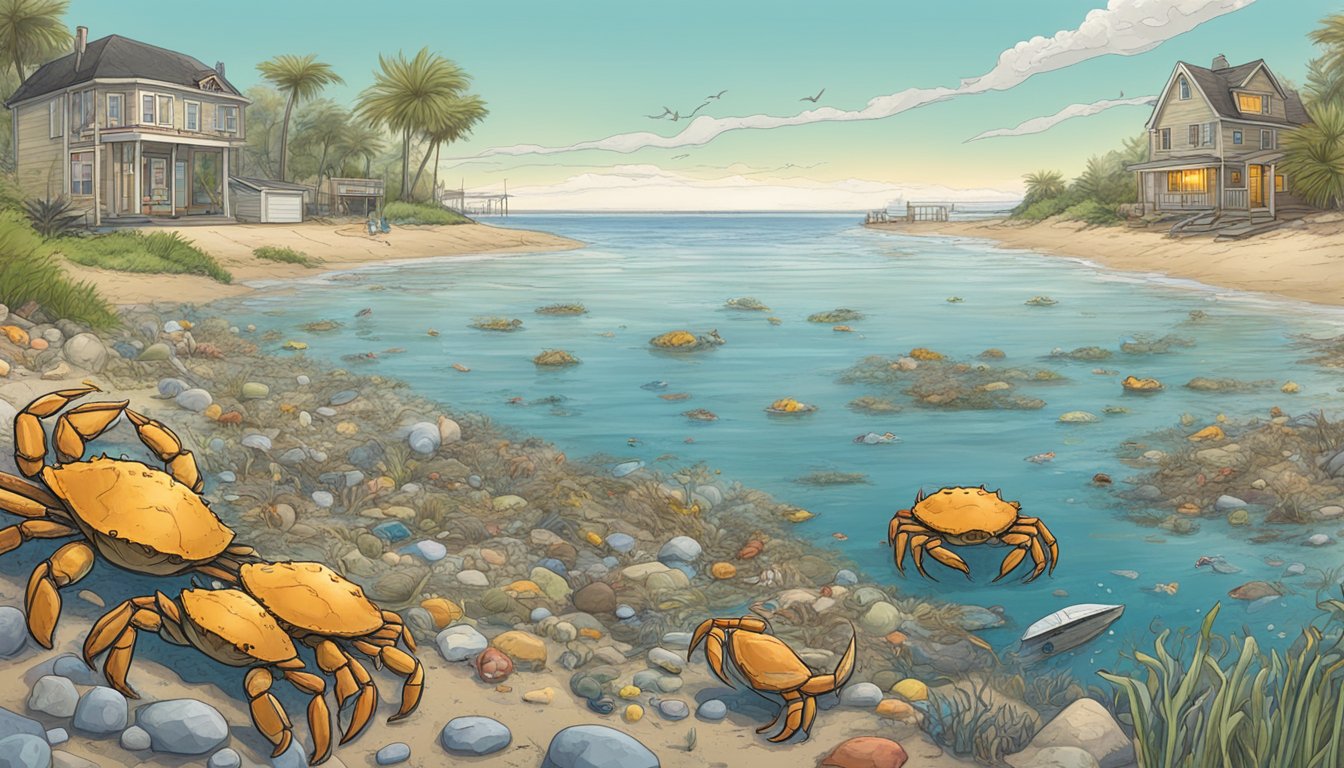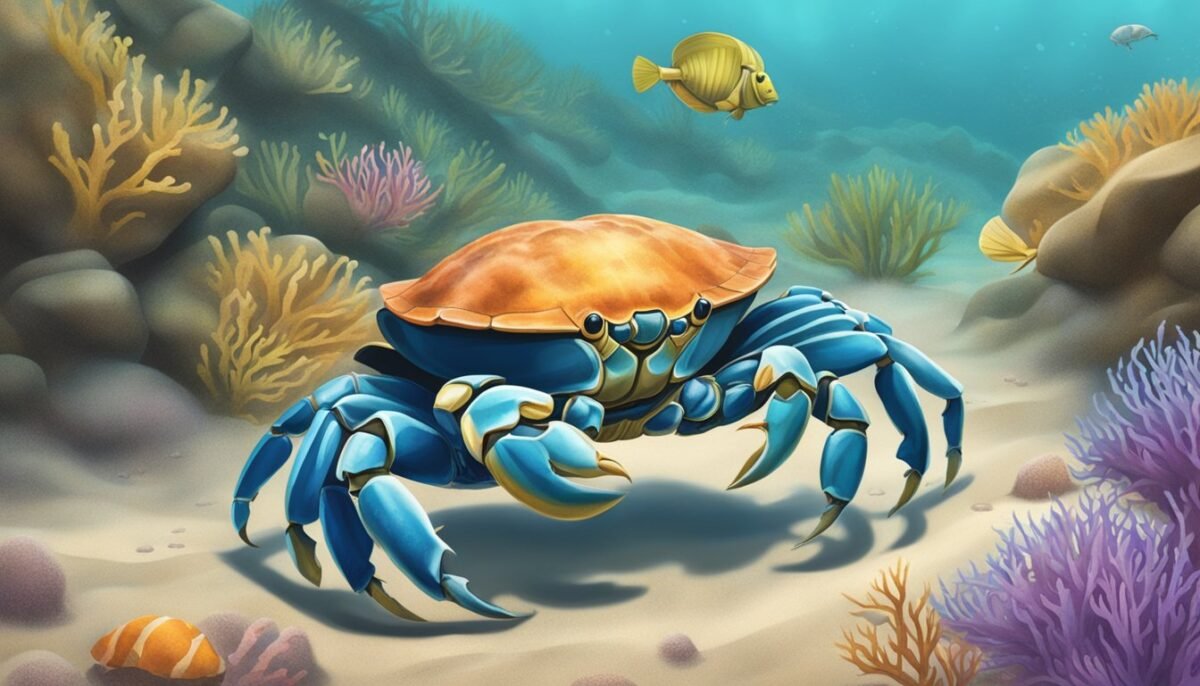Crabs are fascinating creatures that inhabit a variety of environments across the globe, each species adapted to its unique home. They are primarily found in saltwater habitats, such as the ocean’s shores, including sandy beaches, rocky coastlines, and tidal pools. However, many species also thrive in freshwater and terrestrial ecosystems. These habitats provide crabs with the necessary conditions for their survival, which include access to food, shelter, and mating opportunities.

The diversity of crab habitats is wide, ranging from the deep sea to coastal estuaries, and even extending to forest floors and burrows inland. For instance, the fiddler crab prefers muddy areas in salt marshes and mangroves, while the coconut crab, the largest terrestrial arthropod, resides on land, often burrowing underground or hiding in rock crevices. These different environments impact the physical characteristics and behaviors of crabs, influencing their movement, feeding patterns, and reproductive strategies.
Particular species have evolved to live in highly specialized habitats. The yeti crab, for example, has been discovered near hydrothermal vents deep in the ocean, relying on the warmth and chemicals released by the vents for survival. Their impressive adaptability and varied choice of habitat demonstrate the incredible evolutionary success of crabs in environments around the world.
Crab Habitats

Crabs exhibit remarkable diversity in where they live, favoring environments ranging from shallow coastal waters to deep sea vents.
Coastal Waters
In coastal waters, crabs thrive in both saltwater and brackish environments. Species such as the blue crab (Callinectes sapidus) are commonly found up to a depth of 200 meters, but they are mostly spotted around bays and coastal lagoons where salinity levels are suitable for their survival.
Estuaries and Mangroves
Estuaries and mangroves provide a rich habitat for various crab species, which use the intricate root systems for shelter and feeding. The mangrove crab (Perisesarma bidens), for example, plays a crucial role in the mangrove ecosystem by aiding in nutrient recycling.
Intertidal Zones
The intertidal zones, areas between high and low tide, are home to crabs like the rock crab (Cancer irroratus) where they exploit the changing tides. They hide in crevices or bury themselves in sand to evade predators and await the return of the tide to feed.
Crab Species Diversity

Crabs exhibit remarkable diversity, occupying various habitats across the globe. They are categorized based on their environmental adaptations, which include freshwater, terrestrial, and deep-sea ecosystems.
Freshwater Crabs
Freshwater crabs thrive in rivers, streams, and lakes away from the ocean. A noteworthy example is the genus Potamon, enduring in rivers across Eurasia and Africa. These species often display adaptations like flattened bodies for easy concealment under rocks.
Terrestrial Crabs
Terrestrial crabs, such as the Christmas Island red crab (Gecarcoidea natalis), predominantly dwell on land but require proximity to the ocean for reproductive purposes. They have distinct features like lung-like organs for breathing air.
Deep-Sea Crabs
Deep-sea crabs inhabit the ocean’s abyss, like the Yeti crab (Kiwa hirsuta), discovered near hydrothermal vents. They have specialized traits enabling them to endure high pressure and low temperatures found in these depths.
Crab Shelter Types

Crabs seek shelter that provides protection from predators and the environment. Their chosen habitats also offer optimal conditions for feeding, mating, and molting.
Burrows and Holes
Many crabs, such as the fiddler crab, create burrows in sand, mudflats, or estuary banks. The depth and complexity of these burrows vary by species but serve as a refuge from predators and extreme temperatures. Some species can create burrow systems that reach several feet deep. The blue land crab, for example, digs burrows that are typically 1.5 inches in diameter and can extend up to 5 feet downward.
Under Rocks and Debris
Rocky shores and coral reefs provide ideal shelters for crabs, where they can hide under rocks, coral branches, and debris. This environment not only offers protection but also opportunities to scavenge for food. The Sally Lightfoot crab often lives amongst rocks in the intertidal zone, where it can easily escape into crevices or beneath seaweed to avoid detection.
Human Impact on Crab Habitats

Human activities significantly affect crab habitats, chiefly through pollution and habitat destruction, while conservation efforts attempt to mitigate these impacts.
Pollution and Habitat Loss
Pollution from industrial, agricultural, and urban sources degrades water quality, thus impacting crabs directly. Heavy metals, pesticides, and plastic waste not only deteriorate the water where crabs reside but can also accumulate in their bodies, harming their health and that of their predators. Oil spills are particularly devastating, often smothering marine life and destroying the delicate balance of coastal ecosystems.
Habitat loss also poses a severe threat to crabs. Coastal development for housing, tourism, and industry physically alters and fragments the natural landscapes crabs depend on. The destruction of mangroves and wetlands—crucial for the lifecycle of many crab species—reduces nursery grounds, leading to population declines.
| Threat to Habitat | Consequences for Crabs |
|---|---|
| Industrial pollution | Accumulation of toxic substances |
| Coastal development | Loss of breeding and feeding grounds |
| Agricultural runoff | Eutrophication and dead zones |
Conservation Efforts
To counteract these detrimental effects, conservation efforts focus on protecting critical habitats and reducing pollution. Marine Protected Areas (MPAs) are established to safeguard entire ecosystems, including those vital for crab populations. These protected regions limit human activities, thus fostering a safe environment for many marine species.
Organizations and governments also implement regulations to manage pollutants. Anti-pollution laws aim at reducing the discharge of harmful substances from industries and farms into the oceans. Meanwhile, clean-up initiatives are commonly organized to remove plastic and other waste from beaches and coastal waters.
| Conservation Strategy | Aim |
|---|---|
| Establishment of MPAs | Protection of natural crab habitats and biodiversity |
| Anti-pollution laws | Control and monitor discharges from industrial and agricultural sources |
| Beach and ocean clean-ups | Removal of pollutants, especially plastic, from crab habitats |
Crabs in Captivity

Crabs in captive environments are typically housed for public display or scientific research. These controlled habitats are designed to mimic natural conditions to various degrees.
Aquariums
Aquariums provide a simulated natural habitat for crabs where visitors can observe these creatures. Popular species like hermit crabs and fiddler crabs are often featured in touch tanks or display cases. These spaces maintain:
- Salinity Levels: Mimicking ocean conditions for marine species.
- Temperature Control: Ensuring the environment is suitable for the crab species.
- Decor: Including substrates, plants, and hiding places that reflect a crab’s natural habitat.
Research Facilities
Research facilities house crabs to study behavior, physiology, and ecology. They often employ more specialized equipment than aquariums to provide precise conditions for experimentation. Some key elements include:
| Factor | Description |
|---|---|
| Habitat Tanks | Tanks that replicate a crab’s natural environment for controlled studies. |
| Monitoring Equipment | Devices to track health, behavior, and environmental conditions. |
| Isolation Units | Separate enclosures to observe individual or group behaviors without external influences. |
In these facilities, crabs contribute to scientific knowledge and understanding of marine ecosystems.
